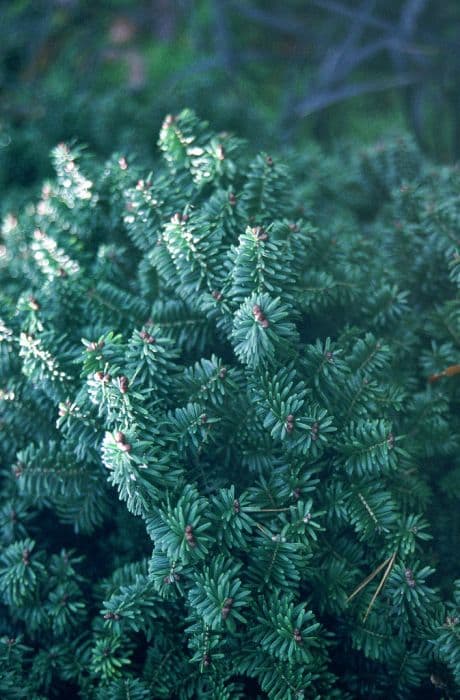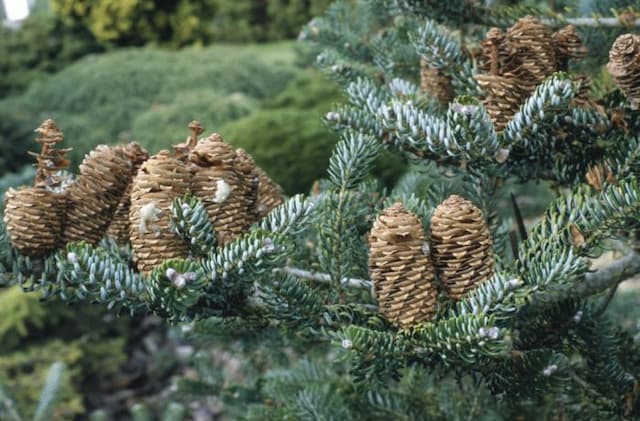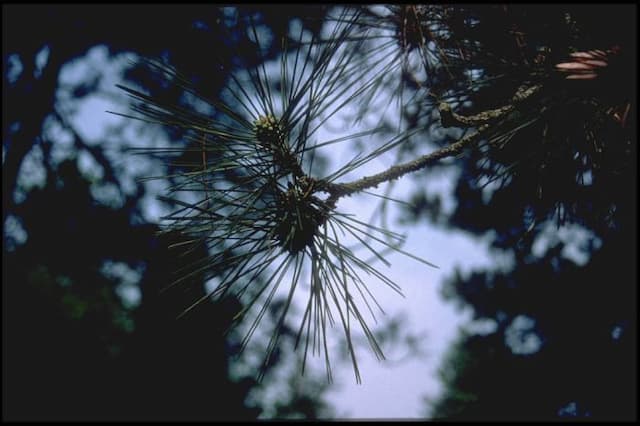Douglas fir Pseudotsuga menziesii

ABOUT
Pseudotsuga menziesii, widely known as Douglas fir, is a coniferous evergreen tree that has a distinctive and graceful appearance. The tree's needles are soft, flat, and usually measure around an inch in length. They radiate out around the twig, creating a generally full look and have a sweet, forest-like fragrance when crushed. The color of the needles can range from a bright green to a more blue-green hue, contributing to its attractive presentation during all seasons. The cones of the Douglas fir are particularly unique and are one of the easiest ways to identify the species. They are medium to large, elongated, and hang down from the branches. Each cone scale has a distinctive three-pointed bract that protrudes from the bottom—a feature that resembles a mouse’s back legs and tail. When it comes to the bark, on young trees, it is thin, smooth, and gray but as it matures, the bark thickens and develops deep grooves, resulting in a rough, ridged texture with a dark brown color. The branches of the Douglas fir are horizontal and tend to droop downward as the tree ages, giving it a sweeping appearance. This characteristic silhouette often becomes picturesque against landscapes, especially under snowfall. The overall shape of the tree is conical, with a relatively narrow crown at the top that becomes broader as it nears the base. Though typically associated with mountainous and forested regions, the Douglas fir is a popular ornamental tree and is also used in reforestation projects due to its adaptability and its appealing aesthetic characteristics. The majestic presence of the Douglas fir, combined with its particular needle, cone, and bark features, makes it a very recognizable and appreciated plant in its native and introduced habitats.
About this plant
 Names
NamesFamily
Pinaceae
Synonyms
Douglas Fir, Douglas-Fir, Oregon Pine, Columbian Pine, Douglas Spruce, Red Fir, Douglas Yew, Douglas-Fir, Douglas's Fir, Oregon Fir, False Hemlock
Common names
Abies douglasii, Abies menziesii, Picea douglasii, Pseudotsuga douglasii, Pseudotsuga taxifolia, Pinus taxifolia.
 Toxicity
ToxicityTo humans
Douglas fir is not generally considered to be toxic to humans. Ingesting parts of the plant is unlikely to cause serious symptoms of poisoning. However, eating large quantities of needles may cause minor gastrointestinal irritation, such as stomachache or indigestion, due to the rough nature of the plant material.
To pets
Douglas fir is generally considered to be non-toxic to pets. It is not known to cause serious symptoms of poisoning if ingested. However, as with humans, consumption of large amounts of needles could potentially cause mild gastrointestinal upset, such as vomiting or diarrhea, due to the indigestible nature of the plant material.
 Characteristics
CharacteristicsLife cycle
Perennials
Foliage type
Evergreen
Color of leaves
Green
Height
70 230 [21.3 meters]
Spread
20 240 [6.1 meters]
Plant type
Tree
Hardiness zones
4-6
Native area
North America
Benefits
 General Benefits
General Benefits- Carbon Sequestration: Douglas fir trees are excellent at absorbing carbon dioxide, helping mitigate climate change effects.
- Wood Production: They are a major source of lumber, providing material for building and furniture due to their strength and durability.
- Habitat Support: They offer habitat and food for wildlife such as birds, squirrels, and insects.
- Erosion Control: Their root systems help stabilize soil and prevent erosion, especially on slopes.
- Recreational Use: Douglas fir forests are popular for outdoor activities like hiking and camping, contributing to human well-being.
- Climate Resilience: They are adaptable to a range of climates, making them valuable for forest restoration and reforestation projects.
 Medical Properties
Medical Properties- Antirheumatic: Douglas fir, as Pseudotsuga menziesii is commonly known, has been traditionally used for its antirheumatic properties.
- Antiseptic: The resin or pitch of the tree has been used for its antiseptic qualities.
- Diuretic: Douglas fir can act as a diuretic, possibly aiding in the elimination of waste from the body.
- Expectorant: The plant is said to have expectorant properties, potentially helping to clear mucus from the respiratory system.
- Stomachic: It has been used to aid digestion and act as a stomachic.
 Air-purifying Qualities
Air-purifying QualitiesThis plant is not specifically known for air purifying qualities.
 Other Uses
Other Uses- Douglas-fir wood is often used to make musical instruments, such as guitars and violins, because it provides a very good resonance, improving the quality of sound.
- The resin from Douglas-fir can be used in the manufacture of glues and adhesives, offering a natural bonding option for various industrial needs.
- Fine Douglas-fir sawdust is utilized in the production of particle board and medium-density fiberboard (MDF), which are common materials in furniture and construction.
- Large-scale Douglas-fir timber is popular in creating veneer sheets, which are thin slices of wood used to cover surfaces for decorative purposes.
- Food industry sometimes uses the Douglas-fir needles to flavor certain artisanal products, such as specialty beers or teas with a unique pine-like taste.
- Dried Douglas-fir cones and branches are often used in floral arrangements and decorative wreaths, especially around the Christmas season.
- The pitch obtained from Douglas-fir can serve as a waterproofing agent for traditional wooden boats and canoes.
- Douglas-fir bark is sometimes used in gardening as mulch to retain soil moisture and suppress weed growth due to its slow decomposition rate.
- Insect-repellent properties of Douglas-fir oils can be utilized for producing natural pesticides that keep away pests from gardens and crops.
- The tannins present in Douglas-fir bark are employed in the tanning industry for processing leather goods.
Interesting Facts
 Feng Shui
Feng ShuiThe Douglas fir is not used in Feng Shui practice.
 Zodiac Sign Compitability
Zodiac Sign CompitabilityThe Douglas fir is not used in astrology practice.
 Plant Symbolism
Plant Symbolism- Strength and Endurance: The Pseudotsuga menziesii, commonly known as Douglas Fir, is a symbol of strength and endurance due to its towering presence and ability to withstand harsh conditions.
- Resilience and Longevity: As Douglas Fir trees can live for hundreds of years, they represent resilience and longevity.
- Growth and Stability: The steady growth of the Douglas Fir tree mirrors qualities of growth and stability in a person's life.
- Connection to Nature: Douglas Fir trees have a deep association with natural environments where they grow, symbolizing a person's connection to the natural world.
- Protection and Safety: In some cultures, Douglas Fir is thought to offer protection and symbolize safety due to its evergreen qualities, representing perpetual shelter.
 Water
WaterDouglas fir trees prefer consistent moisture but do not require frequent watering once established, particularly in their native Pacific Northwest habitat. Newly planted trees should be watered deeply every week with about 10 to 15 gallons of water, especially during dry spells. After the first few years, the Douglas fir will generally require less frequent watering, depending on local weather conditions and soil type. It's important to ensure that the water penetrates deeply into the soil to encourage a strong root system, but be cautious not to overwater as this can lead to root rot.
 Light
LightDouglas fir thrives in full sun to partial shade. The best spot for planting a Douglas fir would be an area where it can receive at least six hours of direct sunlight daily. However, it can also tolerate some shade, especially during the hot afternoon hours, which can help protect the tree in regions with very intense sunlight. Ideally, aim for a location that offers morning sunlight with some protection from the intense late-day sun if necessary.
 Temperature
TemperatureDouglas firs are highly adaptable and can tolerate a wide range of temperatures. They can survive in temperatures as low as -30°F and as high as 90°F, but their ideal temperature range is between 30°F and 70°F. These trees are naturally found in the mountainous regions of the western United States, indicating their preference for cooler climates but with a good ability to adapt to temperature variations.
 Pruning
PruningPruning of Douglas fir trees is generally not necessary for healthy growth, except to remove dead or broken branches which should be done as needed. If pruning for shape or to control size, the best time to prune is in the late winter or early spring before new growth begins. It's crucial to make clean cuts at a slight angle away from the branch collar to promote healing and not to prune more than necessary, as Douglas firs do not vigorously produce new shoots from old wood.
 Cleaning
CleaningNot needed
 Soil
SoilThe Douglas fir thrives in well-drained, sandy loam soils with a pH range of 5.5 to 6.5. A mix of two-thirds loam and one-third sand or perlite can support healthy growth.
 Repotting
RepottingDouglas fir seedlings might need repotting yearly, but mature trees are typically not repotted as they are planted outdoors.
 Humidity & Misting
Humidity & MistingDouglas fir prefers moderate humidity but is adaptable to a wide range of humidity levels as it tolerates different outdoor conditions.
 Suitable locations
Suitable locationsIndoor
Not ideal for indoor growth due to size and light needs.
Outdoor
Plant in well-draining soil; full sun exposure; space generously.
Hardiness zone
4-6 USDA
 Life cycle
Life cycleDouglas fir (Pseudotsuga menziesii) begins its life as a seed, usually germinated in moist, cool conditions. Upon sprouting, it enters the seedling phase, marked by rapid vertical growth and the establishment of a root system. As the tree matures into the sapling stage, it continues to grow in size and height, also developing its characteristic needle-like leaves and woody stems. Eventually, it reaches the mature tree phase, where it can reproduce by producing cones – female cones are larger and carry seeds, while the smaller male cones release pollen. Pollinated seeds are then dispersed by wind or animals, potentially leading to the establishment of new trees. Finally, as a climax species, a mature Douglas fir can live for several hundred years unless affected by disturbances such as fire, pests, or logging.
 Propogation
PropogationPropogation time
Winter to Spring
The Douglas fir, known scientifically as Pseudotsuga menziesii, is commonly propagated through seed collection and germination, which is the most popular method. The best time for seed collection is when the cones have matured, which typically happens from late summer to autumn. Once collected, the seeds are extracted from the cones and can either be sown immediately or stored and stratified to enhance germination rates. Stratification involves keeping the seeds in a cold environment (usually between 34 to 40 degrees Fahrenheit or 1 to 4 degrees Celsius) for a period, which can vary from 30 to 90 days depending on the seed source. After stratification, seeds are sown in a well-drained soil mix, covered lightly with additional soil, and kept moist until germination occurs. It is crucial to provide the young seedlings with appropriate light, temperature, and humidity conditions until they are strong enough to be transplanted outdoors.









